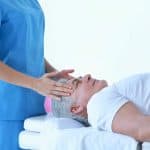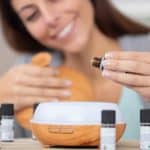Editor’s Note: This article is a follow-up to our previous article The Therapeutic Relationship in Post Traumatic Stress Disorder.
 Want to earn continuing education credit for this article? Learn more.
Want to earn continuing education credit for this article? Learn more.
The therapeutic use of essential oils, known as aromatherapy, is finding its way into the healing arena as an effective and worthwhile contributor in the mind-body-spirit sphere of holistic healing. Carefully selected essential oils are ideal for addressing Post Traumatic Stress Disorder (PTSD). Both physical and emotional aspects of trauma can respond powerfully to appropriate essential oil use. Massage therapists incorporating an integrative approach can include the use of aromatherapy to enhance their work with PTSD clients who display any of the following physical and emotional symptoms associated with the traumatic experience:
- Depression
- Irritability
- Panic and panic attacks
- Self-blame
- Withdrawal from life
- Insomnia
- Headaches and other physical pain
A closer look at the olfactory system and its connection to the brain lends significantly to our understanding of the affect of aromatic essential oils on the physical and emotional aspects of PTSD. Researchers have shown how aromas cause the brain to react activating the hypothalamus gland, the pituitary gland, the body’s hormones and the limbic system. The limbic system links the left and right brain and the voluntary and involuntary nervous system centers.
Smell is processed in the limbic system, the oldest part of the brain in evolutionary terms. The limbic system houses our emotions, sexual feelings, memory and learning. Aromatic essential oil molecules are absorbed in the cilia of the nose, where one end of the olfactory receptors reside, then travel to the olfactory epithelium at the posterior top portion of the nose. The cribiform plate of the ethmoid bone delivers the aroma message to the olfactory bulb located above and behind the nose at the base of the brain. From here the message is amplified and then transmitted to the limbic system and the hypothalamus.
In her book, Molecules of Emotion, Candice Pert, PhD, states that 85 percent of the neuropeptide receptors for emotion are located in the limbic structures. This means that the sense of smell can bypass other cognitive structures in the brain facilitating a more direct and strong association of memory and smell. For example, a favorite aunt who held and rocked you to sleep when you were an infant wore lavender, and now, as an adult, the smell of lavender conjures up the memory of being comforted and loved. In this instance, lavender may assist you with restful sleep. The opposite effect is possible if your aunt who wore lavender was cruel and scared you as a child. In this situation, the smell of lavender may be unpleasant and produce some feelings of discomfort, even if you did not consciously associate the smell of lavender with her. Depending on the association, using lavender with a client could be either soothing and nurturing, or it could exacerbate feelings of irritability and depression.
The theory of Neurolinguistic Programming, or NLP, attributes the association of a particular smell with the emotional memory to the concept of anchoring. Anchoring is the internal process by which the brain forms a connection between the event and the memory associated with the event. Using the above example, the essential oil of lavender becomes the anchor that defines the association between your aunt who was either loving or scary and the associated memory of feeling either security or discomfort.
Therapists can use this associative process to anchor changes in behavior and emotions when working with those with PTSD. Sheryll Ryan, a certified aromatherapist and author of the Institute for Integrative Healthcare Studies’ Aromatherapy Essentials, instructs therapists to anchor any emotional shifts made during therapy with the application of essential oils. Individual essential oils work well, but a blend is often more effective because of its complexity or synergy of smell. A blend will circumvent the cognitive brain’s attempt to identify the smell, and the process of anchoring the “new” feeling will be met with greater success.
Creating useful and potent blends of essential oils to use as anchors when working with PTSD clients is an interactive process that takes place between practitioner and client. In her article Aromatherapy, Jeanne Rose recommends using spikenard and rose for women who have been affected by painful sexual, psychological or physical traumas. Blended, they are considered to be “spiritually uplifting and capable of encouraging pure love and true forgiveness.”
The grounding and calming properties of spikenard complement the angelic qualities of rose and when inhaled or applied to the skin can lift one above personal pain. Together they are powerful for healing the emotional wounds from trauma. Spikenard has a regulating action on the nervous system when inhaled and a calming effect on the heart when inhaled or applied topically. Creating a warm and stabilizing effect, spikenard helps one overcome emotional wounds, grief and deep anxieties.
Rose, called “the queen of flowers,” has the ability to heal the self-blame associated with deep emotional wounds by awakening the heart and opening one to a deeper sense of self-love. Rose also acts on the liver with its cleansing and cooling properties and can help reduce anger and depression. Two drops of rose on a tissue placed under the face-rest of a massage table during bodywork in the prone position, or on a cotton ball placed under one’s pillowcase before bedtime, induces relaxation and can help with insomnia. The client can inhale rose, the anchor, anytime during the day or night to revive the associated feeling of being relaxed during therapy. Lemon oil added to the spikenard and rose formula will lighten the scent.
In addition, the following comforting essential oils are specified for emotional needs:
- Cedar – calming, protective and grounding
- German Chamomile – anti-inflammatory, soothing and calming
- Roman Chamomile – antidepressant, restorative and sedative
- Clary Sage – relaxing and euphoric
- Helichrysum – wound-healing for deep traumatic bruising
- Lavender – gentle and healing effects, migraines
- Ylang-Ylang – sedating and antidepressant
The following blends are women’s formulas suggested in Jeanne Rose’s article Aromatherapy:
Emotional Trauma
9 drops Rose
5 drops Spinkenard
2 drops Lemon
1 oz. carrier oil
Physical Trauma
3 drops Rose
4 drops Spikenard
3 drops Helichrysum
1 oz. carrier oil
Fearfulness and Withdrawal From Life
3 drops Rose Geranium
3 drops Spikenard
4 drops Lavender
1 oz. carrier oil
Although these formulations were created for women, aromatherapy transcends gender. A blend will be effective when it invokes a positive reaction from the client.
The mind-body connection is very obvious in the case of panic attacks. A thought of the past trauma begins in the mind and can set off a whole range of physical sensations such as hyperventilation, perspiration, dizziness, fainting, nausea and shaking. The heart can start to race, the breath can be difficult to catch and, with some people, it may feel as if they are having a heart attack. Although it may feel as if one is dying, panic attacks do not last long and the body gradually returns to normal. Lavender essential oil applied directly on the chest and neck area, combined with deep and slow abdominal breathing, can help prevent or manage an oncoming panic attack. Lavender mixed with a carrier oil is excellent for massaging the abdomen, shoulders and neck of a client suffering from panic attacks. Infuse lavender in the room during a massage to create a relaxing atmosphere and have the client take a bath using 5-10 drops of lavender before bedtime to assist with restful sleep.
Valerie Ann Wormwood, in her book The Fragrant Mind, suggests the following blend of essential oils to address panic attacks:
Panic Attack Calming Blend
10 drops Lavender
5 drops Frankincense
10 drops Helichrysum
5 drops Marjoram
1 oz. carrier oil
Research studies have confirmed lavender’s success in helping people cope with traumatic experiences. When lavender was used before and during examinations, college students reported that their test taking experience was one of calmness and clear thought. A significant number of patients using lavender before and during magnetic resonance imaging reported less anxiety than the control group. Used in massage therapy at the Royal Sussex County Hospital, lavender significantly decreased blood pressure, heart rate, respiratory rate, pain and wakefulness. Further studies have shown the depression levels of elderly people living in assisted facilities were reduced when the aromas of lavender, rose, chamomile, jasmine and rosemary were diffused into the air in various living areas.
Science is finally proving what aromatherapists have been saying for years — Aromas improve performance, increase alertness, initiate relaxation and are powerful vehicles for healing. As humans, we have the ability to distinguish between 10,000 different aromas and each one can take us to a multitude of physical and/or emotional responses. Helen Keller summed up the dynamic impact of the olfactory system on our lives when she said, “Smell is a potent wizard that transports us across thousands of miles and all the years we have lived.”
As a skilled massage therapist assists PTSD clients in the release of patterns held in the body’s tissues, buried emotions and repressed memories, aromatherapy can assist in anchoring the transformed feelings of courage, self-love and forgiveness. These transformed feelings can be experienced and reinforced using essential oils anytime, in the company of or absence of others. Over time the trauma gives way to the newly developed coping mechanism. Massage therapists can facilitate this transformation by supporting clients with safe nurturing touch and using the healing energy of essential oils.
Earn continuing education credit for this article contained in our Post Traumatic Stress Disorder (PTSD) & Massage series. Click here to enroll.















